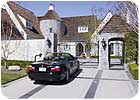
There are four classes of gate operators. Class 1 is a residential gate operator.
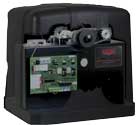
This view shows a cutaway of the Patriot solar residential slide gate operator.
When planning and installing such systems and selecting the proper gate operator, dealers and integrators must consider a range of factors. The three most critical, according to Randy Baker, product manager for manufacturer Linear/Osco, Casnovia, Mich., are “the weight of the gate, its length and the duty cycle — or how many times it will be used in a day.” Baker says one of the most common installation errors he sees is the use of a light-duty gate operator for a high-duty cycle application.
Dealers also must consider the class of device required when selecting a gate operator. As Rick Sedivy, director of marketing for manufacturer DoorKing Inc., Inglewood, Calif., explains, there are four classes of gate operators. “Class 1 and 2 are residential and commercial, respectively,” explains Sedivy. “Class 3 is limited access and Class 4 is restricted access. Limited access systems are designed for industrial locations such as loading docks that don’t serve the general public. Restricted access equipment is used in airport security areas or prisons and is typically operated by security personnel.”
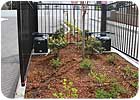
These swing gates control entry onto this commercial campus.
Although some entry control systems are stand-alone, others may be part of a larger access control system, enabling security dealers to choose from a wide range of access control devices. Some of these are identical to proximity card readers or wireless keyfobs that might be used in pedestrian systems. “That’s fine if you can roll down the window,” notes Bill Gioia, marketing manager for gate and access controls for The Chamberlain Group, Elmhurst, Ill. “We find that a lot of customers prefer a transmitter they can put in their car.”
Although systems based on in-car transmitters tend to be more costly than pedestrian-style systems, the upside is that they provide an extra level of convenience by allowing authorized vehicles to simply drive up to the entry control point and automatically gain entrance. Some such transmitters are attached to a car’s license plate holder and communicate with a loop installed underneath the pavement, while others attach to a car’s front window and broadcast to a reader installed at the entry point.
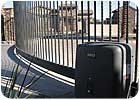
Planning is key when designing an entry gate installation. This property required a unique, curved gate for the installation.
Entry control systems are available in a wide variety of form factors today. Depending on the requirements of a specific job, such systems can simplify installation and improve system esthetics, notes Samuel Shames, chairman of Chicago-based manufacturer Talk-A-Phone. He notes, for example, that some systems have dual-pedestal mounts to accommodate access control readers, while others have built-in cameras or faceplates for pinhole or pan/tilt/zoom cameras.
An easily overlooked, but potentially critical element of an entry control system is surge protection. “Electronic control boards are very expensive,” notes Kevin Pedersen, access control manager for manufacturer Master Halco, Orange, Calif. “You can spend $50 on surge protection and save the cost of a $500 board — and it helps with the maintenance contract to the customer. All it takes is a couple of warranty calls and your profit is gone.”
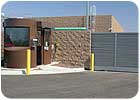
A surface mounted Talk-A-Phone emergency/information phone, integrated with an HID card reader, assists access control at an entry/exit station on an industrial campus in California.
Design and planning
Whatever equipment is selected for an entry gate installation, sources agree that proper planning is key. “The first place to start is with a good architectural design that includes the geography of where the system will be installed,” advises Boriskin.Dealers should pay close attention to the wire runs that will be required and should make sure they consult manufacturers’ guidelines in choosing the appropriate gauge wire. Chuck Stevens, vice president of marketing for Linear, Carlsbad, Calif., encourages dealers to run more wire than needed to meet current requirements. “They should put in at least two spare pairs for future needs,” notes Stevens.
Dealers also must decide how they want to accommodate variations in vehicle heights when card readers are used. One choice is to put in two readers — a tall one for trucks and sport utility vehicles and a lower one for cars. Alternatively, some dealers are able to get by with just a single reader — but if so, mounting height becomes critical.

A gated residential community often uses a dual-swing gate operator.
Installation and safety
If a job has been carefully planned, the actual installation process should go smoothly. A critical milestone may be involved, however, if the installation must be wired for power. Because power wiring involves high-voltage work, security dealers typically need to call in licensed electricians to handle that part of the job — and it’s important for the electricians and security installers to work together smoothly.“It requires close coordination to fire it up and make it work,” notes Baker, who advises security dealers to install any equipment needed to meet requirements for gate safety while the electricians are there.
If not installed properly, gate operators can be extremely dangerous, particularly to pedestrians. Security dealers should be familiar with several important safety standards before installing any gate operators.
These safety standards include the ASTM F2200 construction standards for automated gateways published by the American Society for Testing Materials and the UL325 standard from Underwriters Laboratories, which also focuses on gate operator installation. These standards describe various installation safeguards aimed at moving the gate out of harm’s way in the event that it comes too close to a pedestrian.

This entry control system includes an ornamental slide gate with telephone entry and camera system.
For some installations the gate also may be required to reverse operation if it physically touches something. Installers also should check with local authorities to determine whether the gate should fail safe or fail secure in the event of a power failure.
Even when an installation is done perfectly, it’s also important for customers to understand how it works to ensure long-term success. “We strongly recommend a post-installation checklist to educate the customer on how the system works and what [happens] if there is an emergency,” notes Baker. “If people are educated on how the system is supposed to work, it can avoid calls later.”